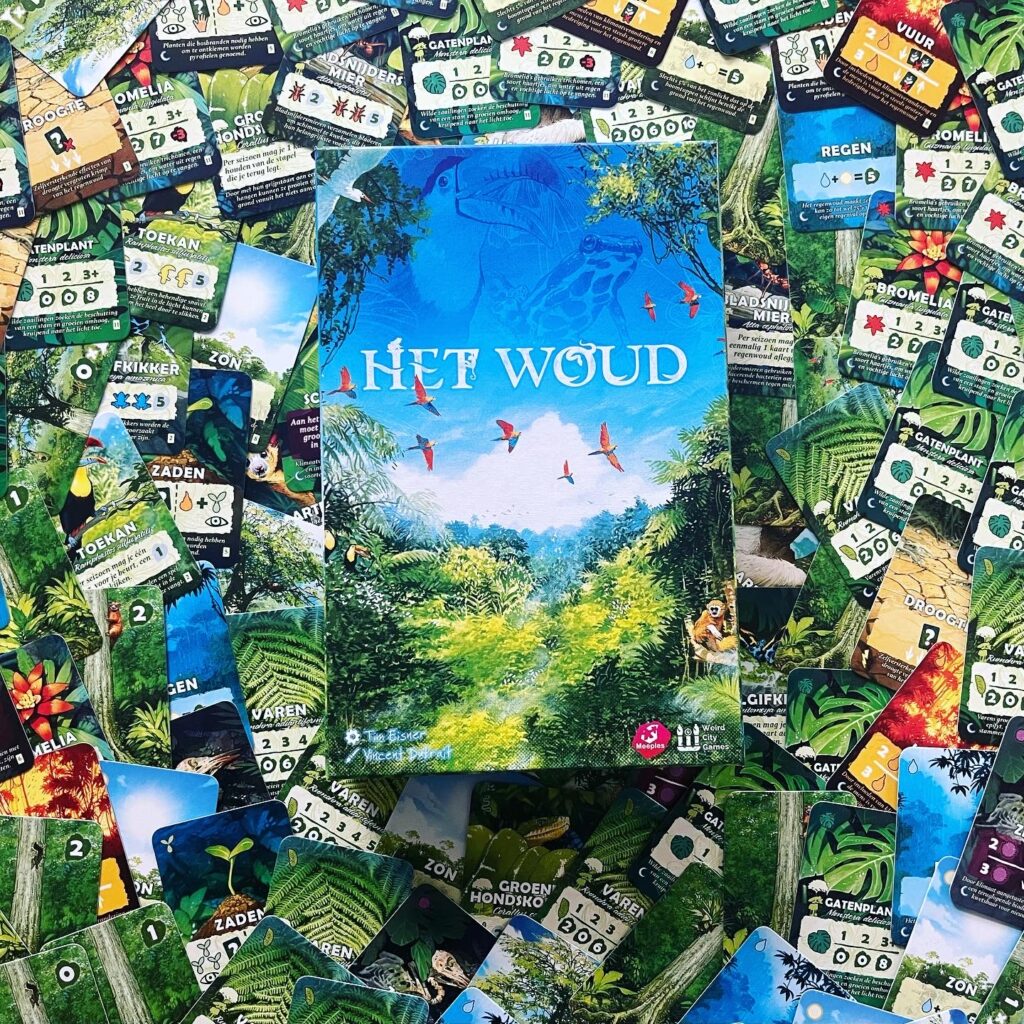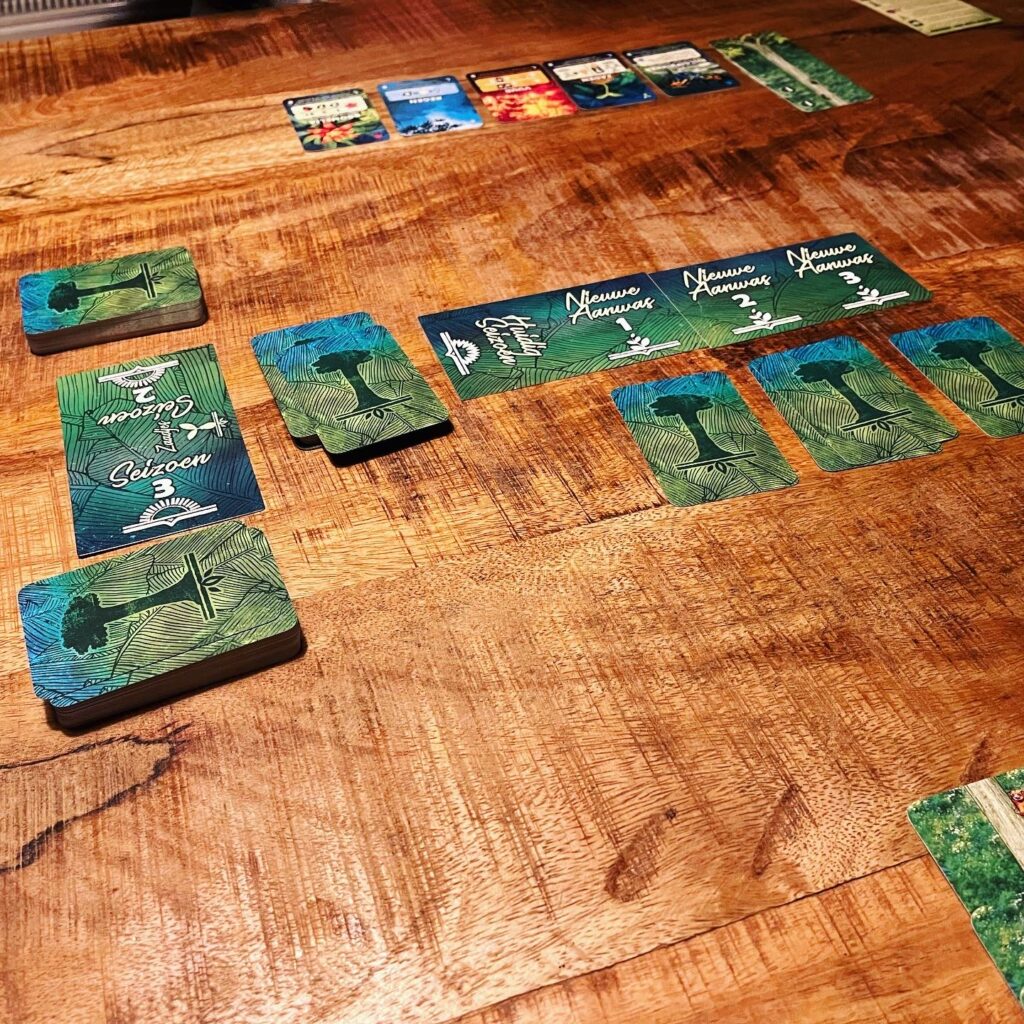Feast your eyes on the most beautiful rainforest with the most colourful plants and animals, but watch out for tropical diseases and forest fires, beForest you know it you won’t end up at the (tree) top.

Background
The English title of this game is Canopy. So you might think of a canopy as a canopy of a building, but the title refers to the tree layer: the part of the forest that contains mainly the tops of trees. In other words, the canopy of the forest. A tropical rainforest is a dense, forested ecosystem in a hot, humid and rainy climate. Consider, for example, the Amazon region in South America. This mysterious and majestic forest is full of special animals, plants, tribes but also a lot of secrets and history. An area we should protect, but unfortunately the rainforest is under threat.
Canopy is a card game by Tim Eisner. You may already know Tim from great board game productions such as The Grimm Forest, Wonderland’s War and Tidal Blades 1 and 2. Canopy revolves around this aforementioned rainforest. In and two players compete to grow the most trees and the right selection of plants and animals in their rainforest. A noble endeavour and thankfully little room for destructive humans. Players are going to save their own ecosystem together and, just like a successful ecosystem in real life, there has to be harmony. By the way, harmony does not have to exist between the two players, as the game is competitive and you can saddle other players with cards they may prefer not to have. More on that later. Do you prefer to play with more players or on your own? Despite the fact that Canopy is basically intended primarily as a duet, there are game modes you can play with more players or even on your own. In the review, I will only discuss the basic game.
Setup and goal
At the beginning of the game, three stacks of the rainforest cards are formed. These three stacks are divided between the players during the three rounds. From the first stack, closed stacks of 1, 2 and 3 cards are made, respectively. The latter stacks are new growths and from those piles cards are actually collected during the game. A stack of seed cards, a stack of animal tokens, point tokens and tree tokens are also placed within easy reach of all players. Each player gets a tree trunk card to start with and they are ready to play.
The rainforest stacks contain various cards with tree trunks, treetops, plants, animals, seeds and threats. With (combinations) of these cards, players score points each round and an important way to score points is by planting and collecting tall trees as each round the tallest tree earns extra points and at the end of the game the player with the most completed trees gets a big bonus.
Gameplay
The game is played in several rounds and each round players start collecting cards. At the end of the round, points are scored based on the cards collected. During a round, players take turns choosing new cards for their forest from three the three small stacks of new ones. Players may look at these piles in order and then choose to keep the pile and place the corresponding cards in your forest or put the cards back, add a new card from the draw pile and look value next pile. Should you not choose any of the three new addition piles to keep, you must add a card from the general draw pile to your forest.
Tree trunks allow players to grow their trees, scoring (a lot of) points. Trees only score when they are completed, and tree tops allow players to complete trees. If you choose a stack with tree tops, you have to (be able to) place tree tops. The rainforest ecosystem depends on heat and moisture, so by making sets with rain and sun, you can score points. Players can also collect points with plants, but each plant has its own conditions. Sometimes you need to collect a lot of this plant species or a specific amount to score points. This is also an important tactical element that influences your decision whether to keep a pile or not, or to try to put certain cards in your opponent’s stomach. Animals provide ongoing bonuses and/or points, and threats sometimes provide bonuses or, conversely, an obligation to discard cards from your forest.
There are also seeds. Adding seeds to your forest gives you a way to draw additional cards from the seed card pile at the end of a round. This pile contains similar cards to the normal draw piles, but give you a way to choose your own cards to improve your forest during the scoring. After each round there is a point count and the end, all cards from that round, except the trees, are discarded and the party starts again.


Verdict
Before I go any further, I must confess that I always have a huge soft spot for Vince Dutrait’s artwork – and blame me! The artwork of Canopy is also beautifully done and I am particularly a fan of the cute tropical monkeys. The plants and trees are also colourful, as you would expect from the rainforest. So in terms of artwork, Canopy is already a winner. I only knew Tim Eisner from lavish productions like the titles I mentioned earlier in this review. Wonderland’s War, in particular, is a very elaborate production full of different game elements. While I am also a huge fan of that and Tim Eisner’s games have been very appealing to me so far, I was pleasantly surprised by the simpler and refined gameplay of Canopy. The game consists mainly of cards and the gameplay is very straightforward. The rules are easy to fathom and despite it being basically a simple set collection game, the gameplay element where players choose from stacks and if they don’t choose the stack is very innovative to me. In this way, the game is dynamic and interactive without being mean and players are faced with a forest full of choices.




